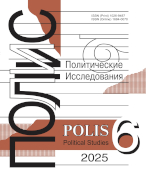Non-military aspects of political interaction in the Caucasus:
comparative analysis of US and Russia approaches
Markedonov S.M.,
MGIMO University, Moscow, Russia
elibrary_id: 251095 | ORCID: 0000-0003-2298-9684 | RESEARCHER_ID: E-9662-2019
Neklyudov N.Y.,
MGIMO University, Moscow, Russia, neklyudov.n.ya@my.mgimo.ru
elibrary_id: 984594 |
Suchkov M.A.,
MGIMO University, Moscow, Russia, suchkov.m@my.mgimo.ru
elibrary_id: 770218 | ORCID: 0000-0003-3551-7256 |
Article received: 18.06.2022. Accepted: 01.09.2022
DOI: 10.17976/jpps/2022.06.12
Markedonov S.M., Neklyudov N.Y., Suchkov M.A. Non-military aspects of political interaction in the Caucasus: comparative analysis of US and Russia approaches. – Polis. Political Studies. 2022. No. 6. https://doi.org/10.17976/jpps/2022.06.12
A great deal of academic research addresses the problems of U.S.–Russian competition in Eurasia. Much of this research examines such issues as strategic stability, the crisis of the European security architecture against the backdrop of NATO’s eastward expansion, and problems of anti-terrorist wars. Yet, the scholarship barely deals with topics comparing the foreign policy disposition of states from a nonmilitary perspective. In this article, we focus on this understudied topic: the assistance projects of the two countries as a means of advancing their national interests in one of the most conflict-prone regions of the former Soviet Union, the South Caucasus. The authors explain how the two countries address them differently, in spite of sharing many of the same threats due to instability in one of the key regions of Eurasia. Thus, this article will significantly broaden the issues of regional security and U.S.–Russian competition defining the place and role in the nonmilitary, politico-economic strategies of Moscow and Washington in the South Caucasus. The article is divided into four parts. First, the authors will provide a conceptual framework for the analysis, revealing the trend of the "geopolitization" of the Caucasus region and showing what is meant by non-military political interaction. Next, the authors will offer an overview of the American and Russian approaches to building political and economic projects in the Caucasus and identify their characteristics. Finally, the authors conclude with a comparative analysis of non-military approaches to regional security in the Caucasus in Russia and the United States.
References
Allison, R. (2008). Russia resurgent? Moscow’s campaign to ‘coerce Georgia to peace.’ International Affairs, 84(6), 1145-1171. https://doi.org/10.1111/j.1468-2346.2008.00762.x
Allison, R. (2017). Russia and the post-2014 international legal order: revisionism and realpolitik. International Affairs, 93(3), 519-543. https://doi.org/10.1093/ia/iix061
Allison, R. (2020). Russian revisionism, legal discourse and the ‘rules-based’ international order. Europe-Asia Studies, 72(6), 976-995. https://doi.org/10.1080/09668136.2020.1773406
Аntonenko, O. (2005). Frozen uncertainty: Russia and the conflict over Abkhazia. In R. Legvold, B. Coppieters (Ed.). Statehood and Security: Georgia after the Rose Revolution (pp. 205-270). Cambridge, MA: MIT Press.
Ambrosio, T. (2011). Unfreezing the Nagorno-Karabakh conflict? Evaluating peacemaking efforts under the Obama administration. Ethnopolitics, 10(1), 93-114. https://doi.org/10.1080/17449057.2011.549731
Brezhneva, A. Ukhova, D. (2013). Russia as a humanitarian aid donor. Oxfam International (Oxfam Discussion Paper). https://www-cdn.oxfam.org/s3fs-public/file_attachments/dp-russia-humanitarian-donor-150713-en_0.pdf
Buzogany, A. (2019). Europe, Russia, or both? Popular perspectives on overlapping regionalism in the Southern Caucasus. East European Politics, 35(1), 93-109. https://doi.org/10.1080/21599165.2019.1588117
Chandler, D. (2010). R2P or not R2P? More statebuilding, less responsibility. Global Responsibility to Protect, 2(1), 161-166. https://doi.org/10.1163/187598410X12602515137617
Dreyfus, E. (2022). Winning hearts and minds. From Syria to Nagorno-Karabakh, the development of populationcentric approaches in Russia’s military interventions. IRSEM (Institut de Recherche Strategique de L’Ecole Militare). Research Paper, 120. Paris: IRSEM.
Drury, A.C., Olson, R.S., Van Belle, D.A. 2005. The politics of humanitarian aid: US foreign disaster assistance, 1964-1995. The Journal of Politics, 67(2), 454-473. https://doi.org/10.1111/j.1468-2508.2005.00324.x
Egger, C., Schopper, D. (2022). Organizations Involved in humanitarian action: introducing a new dataset. International Studies Quarterly, 66(2), sqac009. https://doi.org/10.1093/isq/sqac009
Finnemore, M. (1996). Constructing norms of humanitarian intervention. In P. Katzenstein (Ed.), The Culture of National Security: Norms and Identity in World Politics (pp. 153-185). New York: Columbia University Press. http://users.metu.edu.tr/utuba/Finnemore.pdf
Flake, L.G., & Snyder, S. (Ed.). (2003). Paved with good intentions: the NGO experience in North Korea. Westport, CT; London: Greenwood Publishing Group; Praeger.
Flynn, M.E. (2020). Before the dominos fall: regional conflict, donor interests, and US foreign aid. Conflict Management and Peace Science, 37(1), 39-57. https://doi.org/10.1177%2F0738894217711355
Frear, M., Mazepus, H. (2021). Security, civilisation and modernisation: continuity and change in the Russian foreign policy discourse. Europe-Asia Studies, 73(7), 1215-1235. https://doi.org/10.1080/09668136.2020.1843601
Gresh, G. (2006). Coddling the Caucasus: Iran’s strategic relationship with Azerbaijan and Armenia. Caucasian Review of International Affairs, 1(1), 1-13. http://cria-online.org/Journal/1/CRIA_Winter%2006_Whole%20Issue.pdf
Hehir, A., & Murray, R. (Ed.) (2013). Libya, the responsibility to protect and the future of humanitarian intervention. London: Palgrave Macmillan. https://doi.org/10.1057/9781137273956
Heinrich, T. (2013). When is foreign aid selfish, when is it selfless? The Journal of Politics, 75(2), 422-435. https://doi.org/10.1017/s002238161300011x
Hunter, S.T. (Ed.). (2017). The new geopolitics of the South Caucasus. Prospects for regional cooperation and conflict resolution. Lanham: Lexington Books.
Iskandarov, K., & Gawliczek P. (2020). The ‘new great game’ in the South Caucasus: competition for power and influence. Journal of Scientific Papers “Social Development and Security”, 10(1), 25-33. https://doi.org/10.33445/sds.2020.10.1.4
Jafalian, A. (Ed.). (2016). Reassessing security in the South Caucasus. Regional conflicts and transformation. London: Routledge. https://doi.org/10.4324/9781315603872
Kevlihan, R., DeRouen Jr., K., & Biglaiser, G. (2014). Is US humanitarian aid based primarily on need or self-interest? International Studies Quarterly, 58(4), 839-854. https://doi.org/10.1111/isqu.12121
Kim, T. (2012). Strategizing aid: US–China food aid relations to North Korea in the 1990s. International Relations of the Asia-Pacific, 12(1), 41-70. https://doi.org/10.1093/irap/lcr010
Kim, T., Mok, J.-K., Woo, C., Kim, B.K. (2020). From humanitarian relief to democracy aid: US foreign assistance towards North Korea, 1996-2016. Pacific Focus, 35(3), 585-612. https://doi.org/10.1111/pafo.12173
Leezenberg, M. (2000). Humanitarian aid in Iraqi Kurdistan. CEMOTI, Cahiers d’Etudes sur la Mediterranee Orientale et le monde Turco-Iranien, 29, 31-49.
Lepard, B.D. (2002). Rethinking humanitarian intervention: a fresh legal approach based on fundamental ethical principles in international law and world religions. University Park: The Pennsylvania State University Press.
Markedonov, S.M., & Suchkov, M.A. (2020). Russia and the United States in the Caucasus: cooperation and competition. Caucasus Survey, 8(2), 179-195. https://doi.org/10.1080/23761199.2020.1732101
Mead, W.R. (2014). The return of geopolitics: the revenge of the revisionist powers. Foreign Affairs, XXXIII(2), 81-87. https://doi.org/10.1007/s13398-014-0173-7.2
Nikitin, A. (2020). Legal norms or ad hoc fixes? International legal aspects of Russian military involvement in conflict settlements in the Caucasus. Caucasus Survey, 8(2), 163-178. https://doi.org/10.1080/23761199.2020.1759893
Philips D. (2008). Restoring Georgia’s sovereignty in Abkhazia: policy paper. Washington D.C.: The Atlantic Council of the United States.
Pipinashvili, D. (2011). Sino-Russian geopolitical interests in Central Asia and South Caucasus. Bulletin of the Georgian National Academy of Sciences, 5(2), 144-148.
Rezvani, B. (2020). Russian foreign policy and geopolitics in the post-Soviet space and the Middle East: Tajikistan, Georgia, Ukraine and Syria. Middle Eastern Studies, 56(6), 878-899. https://doi.org/10.1080/00263206.2020.1775590
Rumer, E., Sokolsky, R., & Stronski, P. (2017). U.S. policy toward the South Caucasus: take three. Washington, DC: Carnegie Endowment for International Peace. https://carnegieendowment.org/2017/05/31/u.s.-policy-toward-south-caucasus-take-three-pub-70122
Sadiyev, S.S., Nasirov, E.K., Iskandarov, K.I., & Simons, G. (2021). South Caucasus and a ‘new great game’: the communication of competition in securitised international relations. Journal of Contemporary European Studies, 29(2), 282-294. https://doi.org/10.1080/14782804.2020.1826914
Sakwa, R. (2015). Dualism at home and abroad: Russian foreign policy neo-revisionism and bicontinentalism. In D. Cadier et al. (Ed.) Russia’s Foreign Policy, (pp. 65-79). London: Palgrave Macmillan. https://doi.org/10.1057/9781137468888_5
Smith, H. (2005). Hungry for peace: international security, humanitarian assistance, and social change in North Korea. Washington, DC: United States Institute of Peace Press.
Souleimanov, E.A., Abrahamyan, E., & Aliyev, H. (2018). Unrecognized States as a means of coercive diplomacy? Assessing the role of Abkhazia and South Ossetia in Russia’s foreign policy in the South Caucasus.
Southeast European and Black Sea Studies, 18(1), 73-86. https://doi.org/10.1080/14683857.2017.1390830
Stauton, E., & Jason, R. (2020). The responsibility to protect norm cluster and the challenge of atrocity prevention: an analysis of the European Union’s strategy in Myanmar. European Journal of International Relations, 26(3), 660-686. https://doi.org/10.1177/1354066119883001
Stronski, P. (2020). What will the next U.S. administration mean for the Caucasus and Central Asia? Carnegie Endowment for International Peace. https://carnegie.ru/commentary/83091
Sushentsov, A., & Neklyudov, N. (2020). The Caucasus in Russian foreign policy strategy. Caucasus Survey, 8(2), 127-141. https://doi.org/10.1080/23761199.2020.1759888
Terry, F. (2002). Condemned to repeat? The paradox of humanitarian action. Ithaca, New York: Cornell University Press.
Toal, G. (2017). Near abroad: Putin, the West and the contest over Ukraine and the Caucasus. Oxford: Oxford University Press.
Troulis, M. (2017). The Caucasus in the post-cold war era: from the Soviet republics to a crucial buffer zone. Central Asia and The Caucasus, 18(1), 14-24.
Velikaya, A.A. (2018). The Russian approach to public diplomacy and humanitarian cooperation. Rising Powers Quarterly, 3(3), 39-61.
Wood, R.M., & Sullivan, C. (2015). Doing harm by doing good? The negative externalities of humanitarian aid provision during civil conflict. The Journal of Politics, 77(3), 736-748. https://doi.org/10.1086/681239
Yahyapour, M.S., & GharehBeygi, M. (2016). Hegemonic challenges of Iran and Russia in the Transcaucasia region. Journal of Politics and Law, 9(5), 289-298. https://doi.org/10.5539/jpl.v9n5p289
Yost, D.S. (2015). The Budapest memorandum and Russia’s intervention in Ukraine. International Affairs 91(3), 505-538. https://doi.org/10.1111/1468-2346.12279
Bartenev, V.I. (2011). Securitization of international development aid: political discourse analysis. International Organisations Research Journal, 6(3), 37-50. (In Russ.)
Degterev, D.A. (2013). Russian Federation as a new international donor: identity’s dilemmas. International Organisations Research Journal, 8(2), 69-85. (In Russ.)
Markedonov, S.M. (2021). Post-Soviet de facto states: trajectories of their struggle for sovereignty. World Eсonomy and International Relations, 65(12), 79-89. (In Russ.) https://doi.org/10.20542/0131-2227-2021-65-12-79-89
Neklyudov, N.Ya. (2020). Bound to interpret: Russia, NATO, and the military-political crises in the post-cold war order. Journal of International Analytics, 11(3), 35-60. (In Russ.) https://doi.org/10.46272/2587-8476-2020-11-3-35-60
Primakov, Ye.A. (2018). Russia’s humanitarian mission. Pathways to Peace and Security, 1, 182-196. (In Russ.) https://doi.org/10.20542/2307-1494-2018-1-182-196
Stepanova, E. (2007). Russia’s humanitarian potential and economic rehabilitation of conflict zones. World Economy and International Relations, 5, 65-78. (In Russ.) https://doi.org/10.20542/0131-2227-2007-5-65-78
Tkachenko, M.F. (2018). Russia in the system of international assistance to the development of Central Asian states. Vestnik of Russian Customs Academy, 4, 40-47. (In Russ.)
Zaitsev, Yu.K., & Knobel, A.Yu. (2020). Russian economic development assistance in 2019. Russian Economic Development, 27(12), 16-21. (In Russ.)
See also:
Manoylo A.V.,
Modern Political Conflicts: The Right for Interference. – Polis. Political Studies. 2017. No6
Borov Kh., Dzamikhov K.F.,
Russia and Northern Caucasus (Modern Political Experience in a Historical Context). – Polis. Political Studies. 1998. No3
Analytical Report by the Institute of Sociology, RAS,
Russia’s national security in experts eyes. – Polis. Political Studies. 2011. No3
Sheynis V.L.,
Russia’s national security. durability trial. Part II. – Polis. Political Studies. 2010. No1
Arbatov A.G.,
Nuclear reloading and international security. – Polis. Political Studies. 2011. No3




.jpg)






 print
print
.jpg)
.jpg)